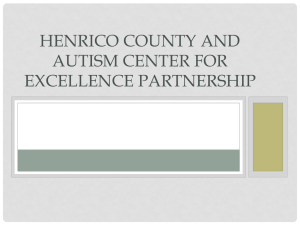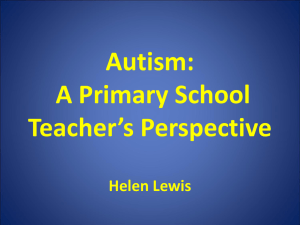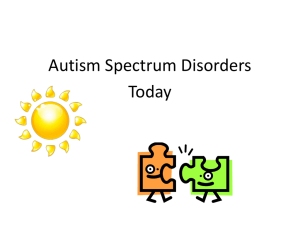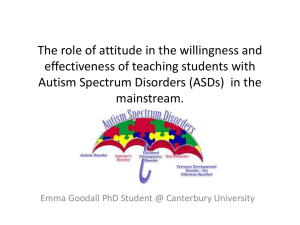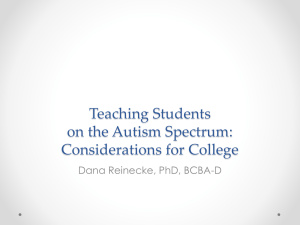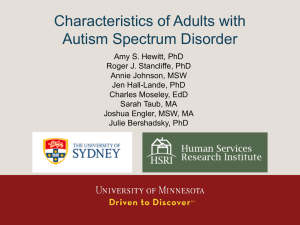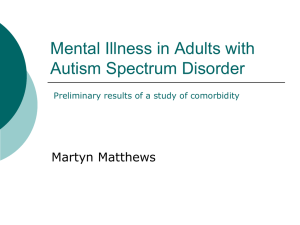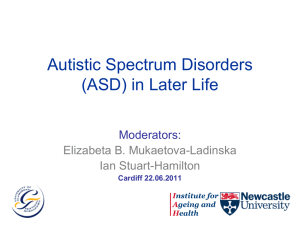Autism Spectrum Disorders and EMS
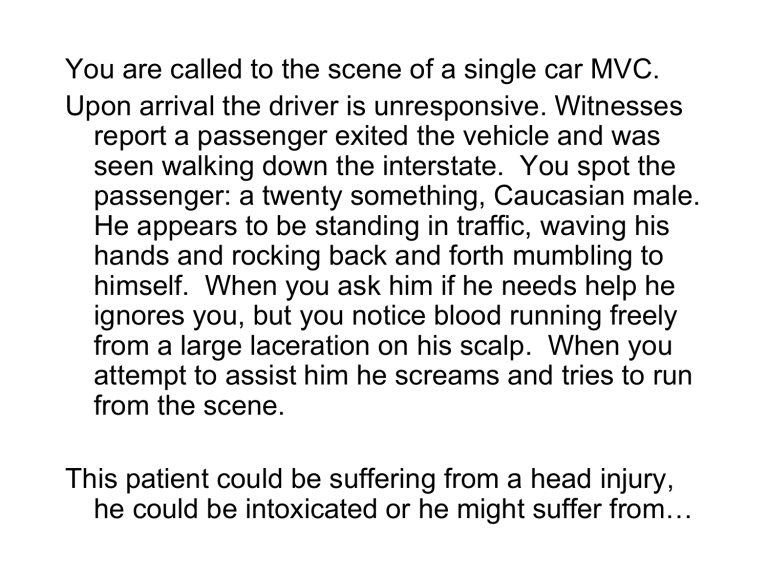
You are called to the scene of a single car MVC.
Upon arrival the driver is unresponsive. Witnesses report a passenger exited the vehicle and was seen walking down the interstate. You spot the passenger: a twenty something, Caucasian male.
He appears to be standing in traffic, waving his hands and rocking back and forth mumbling to himself. When you ask him if he needs help he ignores you, but you notice blood running freely from a large laceration on his scalp. When you attempt to assist him he screams and tries to run from the scene.
This patient could be suffering from a head injury, he could be intoxicated or he might suffer from…
Autism Spectrum Disorders and EMS
The Essentials
Autism - what is it & why do you care?
Autism spectrum disorders are a range of neurodevelopmental disabilities
This means the person is born with it
It is a lifelong condition
Characterized by impairment in communication and social skills, and repetitive, ritualistic behaviors
Prevalence is on the rise
CDC estimates 1 in 110 children diagnosed with
ASD
More common in men than women 4:1
Identification
Click on the link below to view the video.
http://www.vimeo.com/22346214
Tips to Identify Individuals with
ASD
Poor/No eye contact - may be uncomfortable
Repetitive actions - rocking or hand flapping, for example
Fixations/special interests - may be fixated on a particular topic or area of interest (could be with your equipment)
Communication problems
Echolalia - repeat what you say
Monotone voice, inappropriate volume
Non-verbal - may use sign language or pictures to communicate
Inappropriate/unusual attire (shorts in snowstorm, etc.)
Obvious tags (bracelets, cards, database, etc.)
Inappropriate laughing or giggling
Escalation/Meltdown - aggression or anxiety for no apparent reason
REMEMBER - ASD is a spectrum everyone’s unique!!
Probable Encounters
May wander away from caregivers
As many as 23% of people with ASD
Check water sources first (pools, lakes, fountains, etc.)
May look into or even enter other people’s houses
Display unusual behavior that may be misinterpreted as drug/alcohol use
Victims of abuse or other crimes
Roughly 1/3 of all individuals with ASD victim of crime
4-10 times more likely to be the victim of a crime
Sexual abuse much more likely than general populace
Inappropriate exposure or sexual conduct
Probable Encounters
Click on the link below to view the video.
http://www.vimeo.com/22346380
Preparation for Encounters
Keep in mind patient is person first (person with autism versus autistic person)
Education - there are many excellent resources online
Allocate resources to accommodate patient’s needs
Co-morbidities are common
Epilepsy , Obesity, Depression, Mental Retardation, etc.
BE PATIENT !! These calls will likely take more time than a usual call
Allow at least 10 seconds for verbal reply
Suggest a toe-to-head exam to gain trust before inspecting head and neck area (can be very sensitive to touch)
Tips for ASD Encounters
Caregivers are your best friend!!
Use them as you would an interpreter for a non-English speaking person
Create atmosphere of calm
Remove lights/sirens/K-9/crowds/etc.
Maintain good space and calm posture
May only be able to perceive one sensory stimuli at a time
May not recognize First Responders as there to help
Use simple, direct commands
Use openended questions and don’t interrupt person
Avoid slang phrases (“what’s up?”)
Explain what TO do (rather than what not to do)
Some individuals with ASD communicate non-verbally
Don’t disrupt patient’s behavior unless dangerous
Tips for ASD Encounters
Click on the link below to view the video.
http://www.vimeo.com/22347309
Tips for ASD Encounters
Click on the link below to view the video.
http://www.vimeo.com/22346318
Tips for ASD Encounters
Click on the link below to view the video.
http://www.vimeo.com/22346290
ASD Encounters Gone Wrong
Persons with ASD may become aggressive or their actions may present a danger to themselves
If patient’s behavior becomes dangerous engage their caregiver and try to follow recommendations
De-escalation is responder’s primary goal
Person may regain control if given time and space
Remain positive and try to refrain from physical contact
Don’t separate patient and caregiver (during exam, transport, etc.)
If “hands on” approach deemed necessary:
Use minimal restraints needed
Positional asphyxia is a very real risk
Persons with ASD may have a distorted sense of painexamine for injury after restraint
Rescue tips for ASD
People with ASD of any age may hide in closets, under beds, etc. when a fire alarm is going off
May resist rescue - use caution and keep yourself safe
Caregivers may have extra locks, bars on windows, etc.
Both a clue to possible ASD as well as barrier to entry
If possible, remove distractions/danger from scene rather than attempting to remove patient with ASD
May attempt to reenter a burning building or run away from EMS
May not understand danger to themselves or others
Allocate someone to care for person with ASD
Gently wrap person in a blanket to comfort and contain
May be fascinated with water, heights or other dangerous areas (busy roadways, etc.)
What to Remember:
Be alert to the possibility of ASD or other disability
Stay Calm & Positive
Seek out caregivers and follow their advice
Don’t interrupt behaviors unnecessarily
Be Patient
Minimize stress - things to avoid:
Change of routines
Physical contact - especially head and neck
Extreme sensory stimuli
Resources: NJ Disability Training for First Responders, State of New Jersey 2008
Demystifying Autism Spectrum Disorders, Bruey 2004
Autism Information for First Responders, ASA 2009
Introduction to Autism Disorders, Kelble 2009-2010
EMS Implications for Treating the Autistic Patient, Dunn 2010


